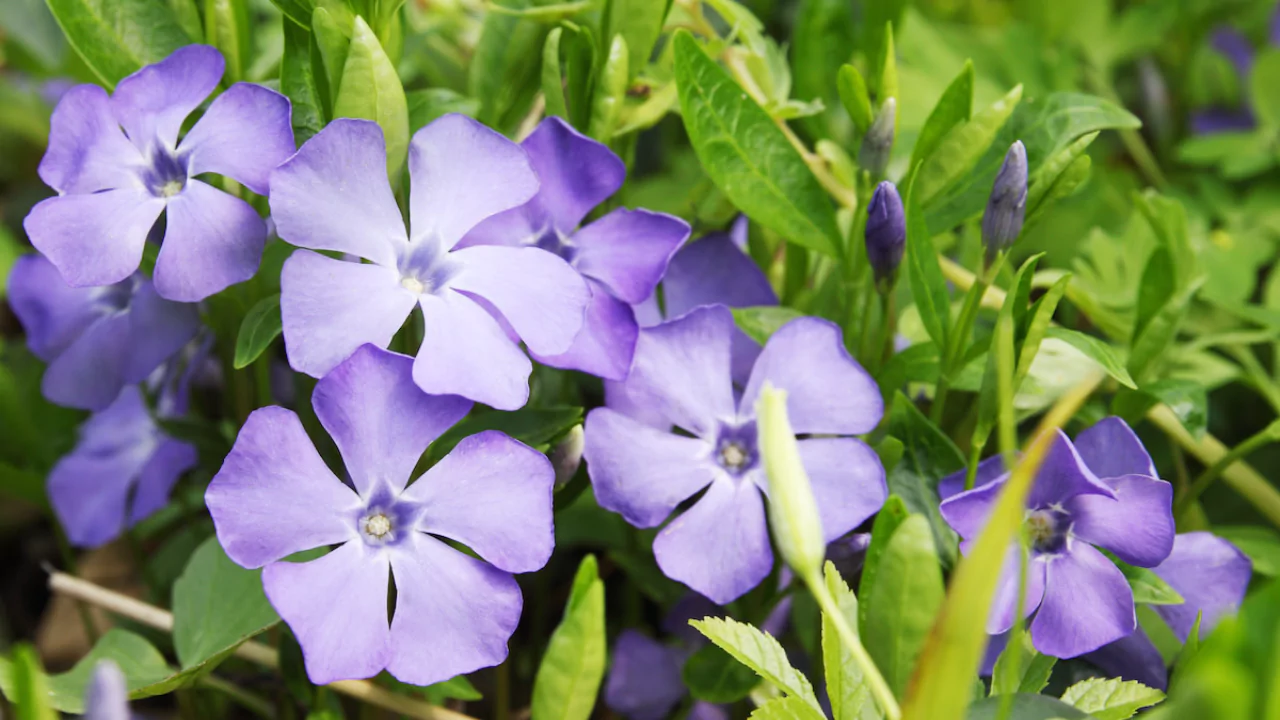
Common periwinkle, or Vinca minor, is a go-to ground cover for difficult areas. Known also as lesser periwinkle or creeping myrtle, it enjoys fertile, mildly damp soil yet accepts clay, alkaline beds, and dry spells with relative ease.
The plant’s shallow, fibrous root system spreads just below the surface, anchoring soil on gentle slopes and cutting down erosion.
Originating in Europe and parts of Asia, Vinca minor thrives in USDA zones 4 through 9 and flowers most profusely in full sun. Still, it settles happily in the shade, which is why many gardeners tuck it beneath trees.
Because the dense mat of roots can out-compete neighboring vegetation, periwinkle is best sown by itself or paired with spring flowering bulbs. Throughout late spring and summer, it produces small blue-purple or white stars above glossy, dark green leaves that stay bold year-round.
Planting and Caring for Periwinkle
Although periwinkle can be started from seed, the germination process is quite slow. A more reliable option is to take divisions from mature plants or purchase nursery-grown plugs. One modest-sized patch soon sends out runners and can blanket a surprisingly large area. Before setting the plants, amend the planting bed with compost, well-rotted manure, and peat moss to improve drainage and encourage quick root growth.
Periwinkle adapts to full sun or dense shade, making it a versatile ground cover in a variety of landscapes. In especially cold climates, a light mulch shields the foliage from biting winds; also water the plants whenever temperatures climb above freezing to guard against winter burn.
Mature periwinkle stands 3 to 6 inches tall and can spread 2 feet or more sideways. For an even carpet, space the divisions 12 to 18 inches apart; this distance allows the wandering stems to knit together without overcrowding. Transplant in spring or early fall on a cloudy day, and water the bed thoroughly afterward. During the first 6 to 10 weeks, keep the soil gently moist while the roots settle in.
As spring growth resumes, apply a slow-release fertilizer, approximately ¼ cup of a balanced 10-10-10 mix for every 100 square feet. In drier regions, a layer of organic mulch helps retain moisture and limits competition from weeds. Because periwinkle is vigorous, excavate and discard any surplus plants whenever it begins to stray beyond its allotted space, especially in rich, moist soil.
Finally, if the foliage starts to look scraggly in late spring, a gentle mow will tidy the area. Just remember to raise the mower blade to its highest setting so that only the tips are trimmed, allowing the plant to bounce back quickly.
Vinca Pest and Disease Potential Problems
Periwinkle, though hardy and long-lived, can fall victim to a suite of diseases when humidity lingers and soil stays wet. Canker, along with root rot, often attacks plants standing in saturated ground. To guard against this, amend the soil for improved drainage and promptly remove any afflicted specimens, disposing of them so pathogens do not spread.
Botrytis blight is another concern. Symptoms include dark leaf spots, wilting foliage, and flowers that shrivel or retain an unusual shape. The fungus thrives in cool, damp air. A copper- or sulfur-based fungicide will help if the outbreak is already under way, yet careful site choice, along with early intervention, always works better.
Avoid planting periwinkle too closely and thin out the plants from time to time. Use drip systems, rather than overhead sprinklers, because wet leaves can spread the disease. Remove any diseased plants promptly and discard dead plant material.
Planting periwinkle too close together invites persistent moisture and poor airflow. Replace overhead sprinklers with drip lines so leaves stay dry. Regular thinning, immediate disposal of infected material, and routine sanitation keep gardens healthy.
Leaf spots and aster yellows occasionally affect the cultivar; both respond to the same management as botrytis. Extract infected leaves, maintain space between plants, and monitor for aphids that spread the yellows virus.
Finally, remember that once periwinkle takes hold, it is stubborn to remove. Choose a permanent bed, stay vigilant, and contain its spread.
Varieties Worth Trying
- Vinca minor Alba produces many tiny, pure-white blooms that stand out against glossy green leaves.
- Vinca minor Atropurpurea features deep purple flowers that add a rich splash of colour to shady spots.
- Vinca minor Bowlesii grows in a strong, mounding habit and offers larger dark-blue blossoms that are showier than most.
- Vinca minor Flore Pleno is one of the rare forms with double flowers, sporting soft purple petals that look almost tissue-paper-like.
- Vinca minor Variegata bears the familiar blue flowers, but its main charm lies in the striking green-and-yellow-striped foliage.